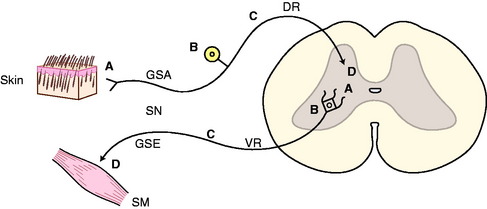CHAPTER 1 Introduction
ACCURATE DIAGNOSIS
Malformations
Malformations are the disorders that result from abnormal development of the nervous system.
Neoplasias
Neoplasias are uncontrolled growth of cells. Primary central nervous system (CNS) neoplasias include the uncontrolled growth of nervous tissue cells—neurons, glia, and ependyma. Metastatic neoplasia of the nervous system is the spread of primary neoplasms in other body tissues to the nervous system.
NEURON
For example, a sensory neuron in the peripheral nervous system for general proprioception may have its dendritic zone in a neuromuscular spindle in a skeletal muscle where it is stimulated by a stretching of the muscle. The axon courses toward the spinal cord through a specific peripheral nerve, then through the dorsal or ventral branch of one of the spinal nerves and into its dorsal root. It then enters the spinal cord and passes into the dorsal gray column of that spinal cord segment to synapse on a second neuron in a nucleus within that gray column. The telodendron is the nerve ending at the synapse on another neuron in that nucleus. The neuronal cell body is located in the spinal ganglion associated with the dorsal root that the axon coursed through to reach the spinal cord. It is actually intercalated in the axon at this point (Fig. 1-1).
Stay updated, free articles. Join our Telegram channel

Full access? Get Clinical Tree



